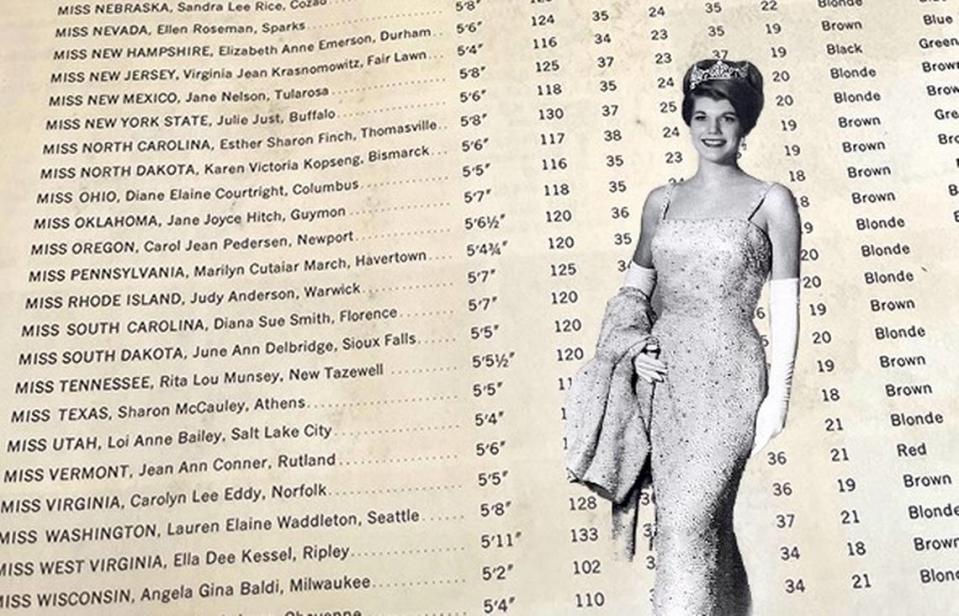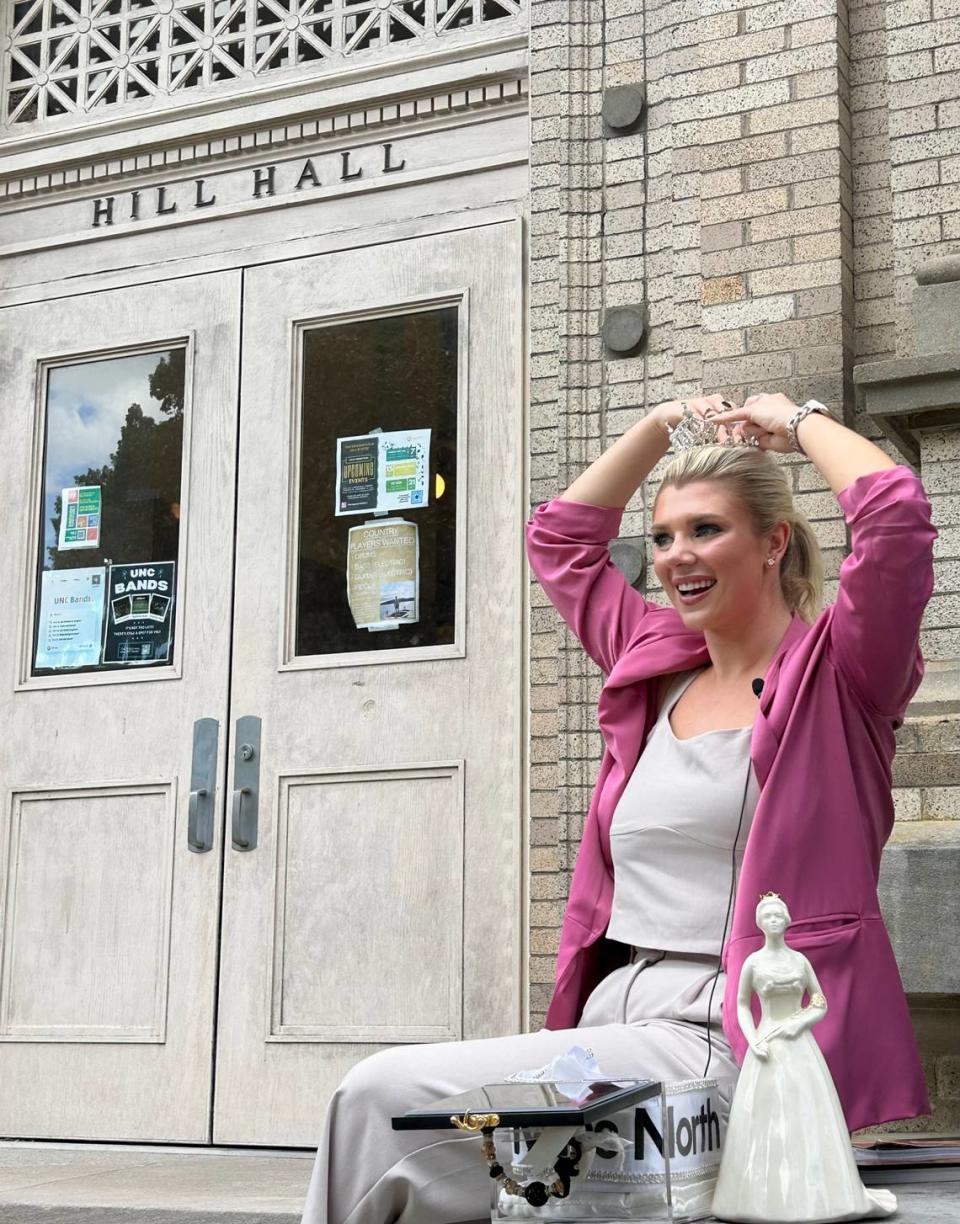From looks to brains: How the Miss North Carolina pageant has evolved over the years
Miss North Carolina 1964 Sharon Finch Van Vechten flipped through the pages of the Miss America program from that year and stopped at page 25.
“Statistics of 1964 Contestants” is the page title. It lists the state each woman represents, her name, height and weight. Then it proceeds to detail her measurements for bust, waist and hips. As she looked at the page, Van Vechten made a sour face and said she was embarrassed that they published such information.
“In the early days, they would put a quarter between the thighs of the contestants,” she said, “and if it didn’t drop you were disqualified. We did quarter turns to be judged like cattle in the state fair. I was ready for feminism after that.”
Van Vechten received a $ 1,000 scholarship for being crowned Miss North Carolina, which she used toward her education at UNC-Chapel Hill. Tuition was $800 a semester.
“When people say ‘college scholarship,’ that’s really a misnomer,” Van Vechten said, “They ought to have just called it a scholarship, but they wanted college in that because they wanted that image of highly educated and also attractive and talented young ladies.”
The Miss America organization, which will crown a new winner Jan. 14, is aware of these issues. It changed the event’s name from Miss America Beauty Pageant to Miss America Scholarship Pageant, and in 2018 eliminated the swimsuit competition. This was dubbed “Miss America 2.0.”
“I think there were some people who were really happy because they saw the suit, as you know, objectifying women,” said Adrienne Sulkey, business manager of the Miss North Carolina Scholarship Pageant. “But I never saw it that way. But then again, I was someone who competed and had my own opinion of it.”

Efforts to increase diversity
One of the problems Sulkey has been trying to solve is the lack of diversity on stage. Sulkey is also the outreach coordinator for Historically Black Colleges and Universities for the state pageant.
In the early years of the pageant, under the leadership of Lenora Slaughter, it implemented Rule No. 7, which stipulated that “contestants must be of good health and of the white race.” The rule was officially abolished in 1950.
“When I competed there (diversity) was very limited,” Sulkey said, “I was used to being maybe one of the only Black women when I would compete in locals. I think it’s important for us to have that representation, because we are out here in the world, and we’re just as smart and talented and beautiful as anyone else.”
Sulkey wants to help the organization expand and bridge new relationships with local colleges and universities, focusing on HBCUs first.
Karolyn Martin, the 2022 Miss NC, described the moment she was on stage and saw history in the making. There were 10 other Black women on stage competing with her; a record-setting number.
“Sometimes you don’t realize that you are in a part of history when you’re in it,” Martin said, “and you don’t realize how big of a moment it is when you’re in the midst of it. But what a beautiful moment.”
Martin’s face lit up as she reminisced about the sister luncheon held the day before she handed over the title. It was the first time she met Deneen Graham, the first woman of color to win the Miss NC pageant in 1983.
“And me, her and Alex Badgett were all there. We are the only three Black women that have held the title of Miss North Carolina,” Martin said.

A way to earn scholarships
Because of the Miss America Organization, Martin was able to graduate debt-free with her undergraduate degree. Martin was awarded $21,000 in scholarship money when crowned; a stark difference to Van Vechten’s $1,000.
Martin is currently enrolled in law school at UNC-Chapel Hill.
“Some of the loans I am taking out now I get to pay for immediately because of Miss America,” Martin said, “It’s one of those opportunities that young women don’t really get anywhere else to earn such an amazing life-changing amount of scholarships.”
Taylor Loyd, the current Miss North Carolina, will compete at the Miss America pageant the week of Jan. 6 to 14 in Orlando, Fla. She is guaranteed $3,000 a month, even if she doesn’t make any appearances or bookings for companies. Van Vechten, who made 471 appearances during her year-long reign, made only $12,500.
As a senior at UNC-Chapel Hill, Loyd has had to come to terms with balancing school, appearances and having a personal life.
Loyd is a double major in psychology and music with a concentration in classical vocal performance. For the talent portion she sang “Amour, ranime mon courage” from the opera “Romeo et Juliette”; she won the talent preliminary.
“I really do think that’s a reflection of how well this university prepares women for the role of Miss NC,” Loyd said. “For this type of job you have to be flexible, carrying that warmth and having that musical skill and technique and knowledge that’s been instilled by so many professors here.”
Loyd is the third music major from UNC-Chapel Hill to win Miss NC. The only time a contestant from North Carolina won Miss America was in 1962, when Maria Beale Fletcher won the national title.
However, it’s not just her talent that led to her success. She described the interview questions as the most important factor in winning the title.
“No matter how good your fitness is or your evening gown is, if you can’t speak you’re not going to win,” Loyd said, “I knew when I won the evening gown portion, it was because they liked my interview. I knew everything revolves around it because if you have a horrible interview, but you have the best talent on stage, you might not win talent.”
Being able to walk into a room and talk to anybody is a skill Loyd said she gained at UNC-Chapel Hill.
When Van Vechten won Miss NC, talent was worth 50 percent of the score, swimsuit was 25 percent and evening gown was 25 percent. Once there were five contestants remaining, judges would ask each finalist one question to determine the winner.
“Talent used to be three minutes at the pageant, now it’s one-and-half minutes,” Van Vechten said, “They’ve cut it down because they’ve put more emphasis on STEM, and this is why they have three interviews instead of one. So it’s much more on the basis of how you come across because that’s the way most people get to see you during the year.”
Loyd believes one of the biggest misconceptions is that she got crowned just for her looks.
“If I want to win scholarship money while wearing a really great dress, who’s to say that it makes me look stupid just because I’m wearing a dress,” Loyd said.
Camille Schrier, a biochemist and winner of Miss America 2020, dressed in a lab coat and gave a colorful chemistry demonstration of the catalytic decomposition of hydrogen peroxide for her talent portion.
In her acceptance speech, Schrier said she hoped to break stereotypes about what it means to be Miss America in 2020.
“They are teachers, they are lawyers, they’re doctors, they’re scientists, and it’s just about being able to see that,” Sulkey said.
UNC Media Hub is a collection of students in the Hussman School of Journalism and Media working to create multimedia packages covering stories across North Carolina.

